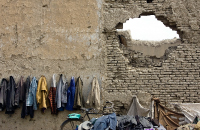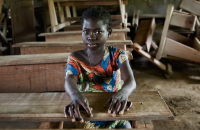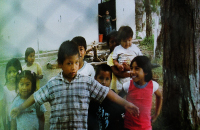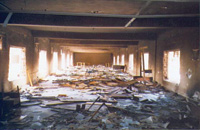Education Under Attack 2014 Country Profiles
There were attacks on education in at least 70 countries during the reporting period, 2009-2013. This section of the study profiles the 30 countries where there was a pattern of such attacks during the four years from 2009 to 2012 and also includes information on key incidents in 2013.
The data presented here are based on reports from different sources and generally not on primary research, and therefore cannot be considered fully verified. The authors have cross-checked these reports as far as possible. The country profiles should be seen as an informed collation and distillation of published reports, which the reader may investigate further according to his or her specific needs.
Countries
The UN reported more than 1,000 attacks on education in 2009-2012, including schools being set on fire, suicide bombings and remotely detonated bombs, killings of staff, threats to staff and abductions. Given the challenges in collecting and verifying reports in Afghanistan, the true number may well be significantly higher.
Following the outbreak of anti-government protests in 2011, students, teachers and academics were arrested from schools and universities and teacher association leaders were imprisoned. There were many incidents of sectarian threats and intimidation in schools and universities that year.461
Most attacks took place after the Séléka rebellion in late 2012 and during 2013. More than 100 schools were damaged, destroyed or looted, two dozen were used for military purposes and there were reports of students and teachers being killed. By early 2013, one in two schools had closed.
Some 140 school teachers were murdered and more than 1,000 school teachers received death threats in 2009-2012, with threats increasing in 2013. Children were recruited from school by armed groups and there continued to be reports of public security forces using schools for military purposes, despite legal curbs.
In Côte d’Ivoire, armed groups and military forces destroyed, damaged, looted or used almost 500 schools and universities during the 2010-2011 post-election crisis.598
Attacks on schools, including widespread looting, damage or destruction of facilities, and fear of abduction and recruitment by armed groups contributed to children missing out on education, particularly in the eastern provinces.635
Political and sectarian tensions led to sporadic attacks against schools, damage and looting of university buildings, and arbitrary arrest and injury of students on campus.675
Arbitrary arrest, ill-treatment and torture of university students, particularly of Oromo ethnicity, were documented, as were surveillance and intimidation of teacher trade unionists.705
Some 140 schools were attacked by militants in 2009-2012, and there was widespread use of schools as barracks or bases by government forces, mostly in the east of the country.
Religious intolerance and tension between religious groups have led to attacks on schools attended by minority Muslim sects and Christian schools in particular.782
Some students were killed when security forces raided university dormitories. Other students and academics were arrested, imprisoned or sentenced to death on charges based on confessions obtained under torture. Academics specializing in nuclear physics and engineering were assassinated.802
More than 100 school students and dozens of university students and academics were killed in 2009-2012, and there were numerous direct attacks on schools. The targeting of students, teachers and academics continued in 2013 with shootings and bombings.
Palestinian schools and universities were targeted with airstrikes, attacked by Israeli settlers and in some cases used by Israeli armed forces as interrogation centres or surveillance posts. Israeli schools were hit by indiscriminate rocket fire.913
Several students and teachers were killed by militants, tribesmen or troops in sporadic attacks on schools or attacks en route to or from school.991
More than 200 schools were used by armed groups during the 2011 uprising against the Gaddafi regime and more than 1,900 schools were damaged or destroyed.1015
Some 130 schools were looted, destroyed or used by armed groups and government forces during fighting in the north of the country, notably in 2012 and early 2013.The conflict caused widespread disruption of education.1041
Teachers in more than 75 schools were threatened, more than 50 students, teachers, academics and education officials were killed or abducted with their whereabouts unknown, and nanotechnology researchers were targeted with bombs in 2009-2012.
Schools were attacked by state armed forces in ethnic conflicts, and students and teachers were targeted during an upsurge of sectarian violence between Buddhists and Muslims in 2013.1123
Many schools were bombed, set on fire or attacked by militants in the north – and increasingly militants turned their attention to students and teachers. Dozens of school teachers were murdered, and at universities there were very heavy casualties in attacks by gunmen firing indiscriminately and in some cases also using bombs.1144
There were a reported 838 or more attacks on schools in Pakistan during 2009-2012, more than in any other country, leaving hundreds of schools destroyed. Militants recruited children from schools and madrassas, some to be suicide bombers. There were also targeted killings of teachers and academics.
The main threat to education came in the Caucasus, where schools were attacked and teachers and academics were murdered.1330
Islamic militants recruited large numbers of children from school and abducted girls for forced marriage to fighters. Suicide bombings targeting students took a very heavy toll, and schools and universities were used as military bases for fighting.1355
Schools were destroyed, damaged and looted by armed groups and armed forces during inter-communal violence and border incursions during 2009-2013. Dozens of schools were used for military purposes, some for up to five years.1427
More than 1,000 university students were arrested, more than 15 killed and more than 450 injured in 2009-2012, mostly in demonstrations on campus or in education-related protests. Many of the injuries resulted from security forces using excessive force. There were dozens of incidents of attacks on, and military use of, schools.1457
Schools were attacked in numerous locations. By early 2013, up to 1,000 schools had allegedly been used as detention or torture centres and 2,445 were reported damaged or destroyed, although it is not known how many were targeted. Attacks on universities caused very heavy casualties.1531
During 2009-2012, more than 120 Buddhist and Muslim students, teachers and education staff were killed or wounded by insurgents in the far south, who also did much of their recruiting in schools in 2009. Widespread military use of schools by armed forces and paramilitary forces made them a target for attack.
There were killings and abductions of teachers, bombing and shelling of schools and universities, with some incidents related to their use as polling stations. The armed forces continued to use numerous schools for military purposes in breach of Philippines’ law.1290
Two dozen schools were bombed or set on fire and 28 teachers abducted in 2010-2012, mostly in the south-east, where Kurdish insurgents were active. Hundreds of university students were arrested in protests that were suppressed with excessive use of force.1655
[Arabic]
There was widespread destruction of schools in direct attacks, including air strikes, bombing, shelling and looting, as well as in general fighting and in clashes during protests. Schools and universities were used as barracks, bases and firing positions.1684
Hundreds of university students were unlawfully arrested or unlawfully detained during 2009-2012, and police and state security forces violently repressed several protests at universities. School teachers faced intimidation and death threats, and some schools were used as militia bases.1760




